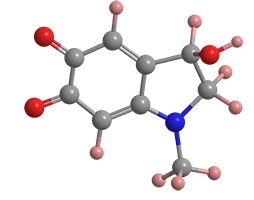What molecule am I?


Adrenochrome is a biomolecule produced in the body by the oxidation of the hormone adrenaline1—hence its name. The “chrome” in its name indicates that it is deeply colored, compared with white adrenaline.
Adrenochrome was known as long ago as 1856, when French neurologist Alfred Vulpian (who also discovered adrenaline) observed that adrenaline turns red when exposed to air. But it was not until 1937 that David Ezra Green and Derek Richter at the University of Cambridge (UK) named the compound and described its isolation and characterization.
The structure of adrenochrome is chiral at the position of the hydroxyl group2. Little information is available on the individual enantiomers. Adrenochrome is an unstable molecule with no practical uses. Its monosemicarbazone (carbazochrome3), however, is stable; it is said to promote blood clotting and can be used to treat hemorrhaging. From the 1950s through the 1970s, adrenochrome was thought to cause schizophrenia, but this theory was eventually debunked.
In recent years, adrenochrome has been implicated in far-right conspiracy theories, such as QAnon and Pizzagate reports of satanic ritual abuse, as described in a July 2023 Forbes article. It has also been touted as a hallucinogen or youth drug.
1. CAS Reg. No. 51-43-4; also known as epinephrine.
2. CAS Reg. Nos.: (R)-enantiomer, 7506-92-5; (S)-enantiomer, 5181-82-8.
3. CAS Reg. No. 69-81-8.
Adrenochrome hazard information
| Hazard class* | GHS code and hazard statement | |
|---|---|---|
| Acute toxicity, oral, category 4 | H302—Harmful if swallowed | |
| Acute toxicity, dermal, category 4 | H312—Harmful in contact with skin | |
Serious eye damage/eye irritation, category 2A | H319—Causes serious eye irritation | |
Acute toxicity, inhalation (dusts/mists), category 4 | H332—Harmful if inhaled | |
| Specific target organ toxicity, single exposure, respiratory tract irritation, category 3 | H335—May cause respiratory irritation | |
*Globally Harmonized System (GHS) of Classification and Labeling of Chemicals. Explanation of pictograms.
MOTW updates
Heme1 was the Molecule of the Week for January 17, 2011. It is a porphyrin derivative and the color component of hemoglobin, which transports oxygen in blood.
Last month, Frances H. Arnold, Kendall N. Houk, and colleagues at Caltech (Pasadena, CA) and the University of California, Los Angeles, described a potential use for heme in organic synthesis. They used computational chemistry to determine the mechanism of iron heme enzyme–catalyzed carbene transfer reactions to synthesize cyclopropane derivatives. The advantage of this method is that the carbene precursors are diazirines, which are air-stable, user-friendly alternatives to traditionally used diazo compounds.
Testosterone2 was the Molecule of the Week for June 14, 2005. It is the primary male sex hormone, the shortness of which in older men can cause fatigue, low energy, and loss of libido.
In January, Martha E. Stone, Max B. Kelz, and Alex Proekt at the University of Pennsylvania (Philadelphia) and collaborators there and at the University of Michigan (Ann Arbor) and Washington University (St. Louis) reported that testosterone is primarily responsible for the difference between male and female behavior under general anesthesia. In a mouse study, the researchers found that, at equal brain concentrations of the inhaled anesthetic isoflurane3, females are more resistant to the anesthetic than males, and that the difference results from testosterone modulation in males.
1. CAS Reg. No. 14875-96-8.
2. CAS Reg. No. 58-22-0.
3. CAS Reg. No. 26675-46-7.
This molecule was suggested by a reader. We present almost all of the molecules suggested by our readers. If you have a molecule you would like us to consider, please send us a message. And thank you for your interest in Molecule of the Week! —Ed.
Adrenochrome
fast facts
| CAS Reg. No. | 54-06-8 |
| SciFinder nomenclature | 1H-Indole-5,6-dione, 2,3-dihydro-3-hydroxy-1-methyl- |
| Empirical formula | C9H9NO3 |
| Molar mass | 179.17 g/mol |
| Appearance | Deep violet crystals or powder |
| Melting point | 125 °C (dec.) |
| Water solubility | 0.3 g/L |

Learn more about this molecule from CAS, the most authoritative and comprehensive source for chemical information.
Molecule of the Week needs your suggestions!
If your favorite molecule is not in our archive, please send us a message. The molecule can be notable for its current or historical importance or for any quirky reason. Thank you!
Stay Ahead of the Chemistry Curve
Learn how ACS can help you stay ahead in the world of chemistry.

